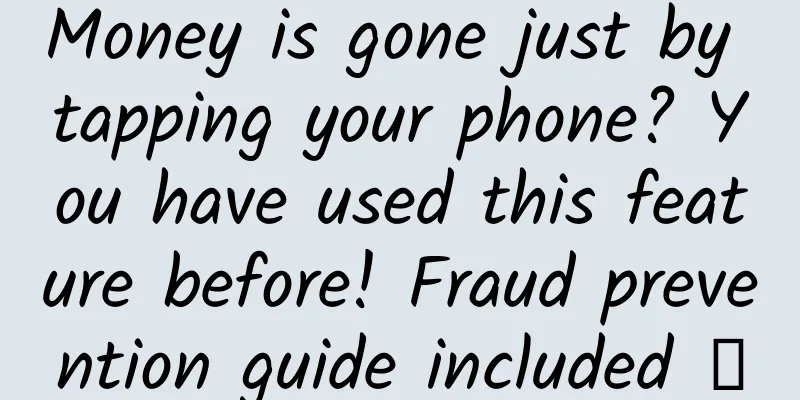Money is gone just by tapping your phone? You have used this feature before! Fraud prevention guide included →

|
In recent years With the popularity of smart phones NFC technology is gradually integrated into people's daily life It has brought great convenience to payment, access control and other fields. But at the same time Frequent incidents of fraud using NFC functions This has aroused strong concern and worry among consumers Image source: pixabay What is NFC? NFC, the full name of Near Field Communication, is near field communication technology. NFC devices send and receive electromagnetic waves through antennas to achieve data exchange. When two NFC devices are close to each other (usually within 10 cm), they can communicate with each other. NFC devices are divided into active mode and passive mode. Devices in active mode can send radio frequency signals, while devices in passive mode can only receive radio frequency signals. Simply put, it allows two NFC-enabled devices to exchange data within a short distance without the need for a network connection. With just a light touch, data transmission is completed instantly, just like building an invisible high-speed channel between devices. During the payment process, the NFC chip in the mobile phone acts as an "electronic wallet", storing bank card information or payment account information, encrypting and authenticating it to ensure the security of the payment process. NFC functions are widely used in public transportation payment, mobile payment, data transmission, access control management, smart home and other fields, as well as special innovative scenarios, bringing convenience to life and work. Case: Mr. Li received a call from someone claiming to be an airline customer service representative. The caller said that his flight was canceled due to mechanical failure and asked whether he wanted to change the ticket or get a refund. Mr. Li chose to change the ticket. The caller further stated that since he had purchased insurance for him, he could return 300 yuan to his bank card, but he had to go through the "Enterprise Payment" operation. Under the guidance of the caller, Mr. Li used his bank card to open the "Rest assured borrowing" service on a certain platform, and borrowed a total of 100,000 yuan in two installments as required by the caller. Subsequently, the caller asked Mr. Li to download a software called "NFO-X" and swipe the card through the NFC function of his mobile phone. Mr. Li completed two large transactions as instructed. When the caller asked him to swipe the card for the third time, Mr. Li noticed something unusual, but he had been defrauded of 98,000 yuan. Ms. Luo received a strange call, and the other party lied that she had opened a "certain member live broadcast service" and would be charged a high fee if she did not cancel it. Ms. Luo added the customer service QQ provided by the other party, and downloaded conference apps and payment tool apps. After turning on screen sharing, Ms. Luo's mobile phone was remotely controlled, and even the screen went black automatically. Afterwards, the other party asked Ms. Luo to place her bank card close to the NFC identification area of the phone and instructed her not to operate the phone. Soon after, the other party sent a false message of "closing membership successfully" and disconnected. After checking with her family, Ms. Luo found that the money in the bank card had been transferred away. How do scammers use NFC to commit fraud? Let's look at the scammers' tactics: ↓↓↓ 1. Impersonating a legitimate identity Scammers will make up excuses such as "flight problems" or "flight cancellation will be deducted" to make victims anxious, and use this sense of urgency to make victims let down their guard. 2. Using NFC to steal credit cards The scammers will ask the victims to use the NFC function to connect the bank card information with their fake software, so that they can directly read the money in the bank card and then transfer the money away. 3Remote control creates panic To make victims more afraid, scammers will also use screen sharing and other technologies to make victims feel that they are operating in a legitimate way, so that victims will trust them more. 4. Spread fake news to gain trust The scammers will also send a fake "cancellation successful" message to make the victim think that everything has been done, so that the victim will not discover that the money has been stolen so quickly. The fraudsters used two mobile phones with NFC function, and attached one of them, phone A, to a POS machine abroad. They used phone A to obtain transaction instructions, and then transmitted the transaction instructions to phone B through the "NFO" software (bank card theft software). Diagram of bank card fraud | Guizhou Anti-Fraud Center When the NFC function of mobile phone B is turned on, once the bank card is close to mobile phone B, mobile phone B can instantly obtain the payment instructions of the bank card. When mobile phone B and mobile phone A are communicating with each other, mobile phone A pretends to be a foreign POS machine and transmits the obtained bank card information to the real POS machine abroad through the NFC function "air card reading". Finally, the foreign fraudsters enter the password on the real POS machine to complete the bank card theft. It can be seen that the core of this scam is to get the victim to download an illegal APP , bind the victim's bank card in the APP, and then directly deduct the money through the NFC payment function. In this process, screen sharing plays a key role. So is the “Alipay tap” in the supermarket safe? Will the money be stolen? No. "Tap and Pay" is a barcode payment method. Users unlock their phones and tap them against the merchant's payment device to make the payment. Multiple security measures are used in the process to ensure user payment security. In addition, the prerequisite for "Tap and Pay" is that the phone must be unlocked first. Nowadays, for security and privacy reasons, smartphones are required to be unlocked by face recognition or password by default. If the password is entered incorrectly several times, the phone will be locked. Therefore, if someone steals the phone, it cannot be unlocked. If someone touches the phone in your trouser pocket, the money will not be swiped away casually. The police reminded people not to perform unfamiliar payment operations through the NFC function at will, and not to agree to screen sharing from strangers for any reason; in addition, unknown QR codes and software should be avoided. If you don't want to use the NFC function, you can also choose to turn it off directly. iOS: Settings → General → Turn off NFC according to the prompt Screenshot Android: (Method 1) Find NFC off in the drop-down menu on the screen Screenshot (Method 2) Settings → More connections → Turn off NFC according to the prompts Screenshot Edit: April |
Recommend
Beware! Be careful when this screen appears on WeChat! These 15 minutes are critical
When using WeChat to transfer money If your phone...
Event planning and promotion, 4 key points to help you plan a screen-sweeping event!
Nowadays, when it comes to event planning, many p...
Can elderly care be more efficient? Bio-radar becomes a new type of "guardian"
Whether it is an accidental fall or forgetting to...
In 2021, the total shipments of mobile phones in the domestic market reached 351 million units, of which 5G mobile phones accounted for about 76%.
According to data released by the China Academy o...
2016 Q3 app rankings, 200 rankings, 18 major fields, 44 charts fully displayed
It was originally thought that the third quarter ...
Analysis of the core principles of high-performance lock-free queue Disruptor and its application in i-theme business
1. Introduction to iTheme and Disruptor iTheme is...
How to customize iOS camera in 30 minutes
Recently, the company's project used a camera...
User growth methodology!
According to the 2019Q1 Mobile Internet Ecosystem...
How to lower user expectations and achieve sustained product growth?
Killing users’ unnecessary expectations and overl...
JD.com 618 Post-Battle Review: A Textbook Marketing Case
This year's 618 Mid-Year Shopping Festival fi...
What will happen to your body if you eat one fried dough stick every day? Is the aluminum content in fried dough sticks really excessive?
Youtiao is the "kingpin" of breakfast! ...
Gifted Mission-How to Live a Powerful and Free Life
Gifted Mission-How to Live a Powerful and Free Li...
The common coconut tree is not the "indigenous" of Hainan.
If you ask what the most common tree in Hainan is...
Hua Chunying responded to the Harvard University COVID-19 paper full of loopholes. Let’s take a look at the details!
The American Broadcasting Corporation reported th...
150,000 pure electric SUV, Nezha X vs. Aion Y Plus, which one should you choose for home shopping?
Not long ago, Nezha Auto released a new model, th...









